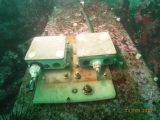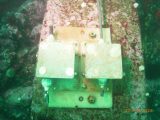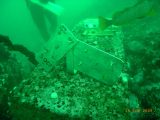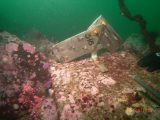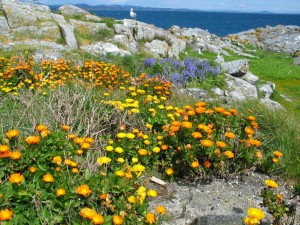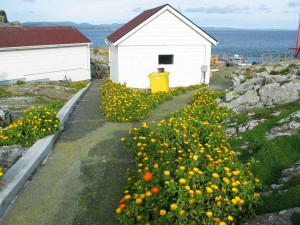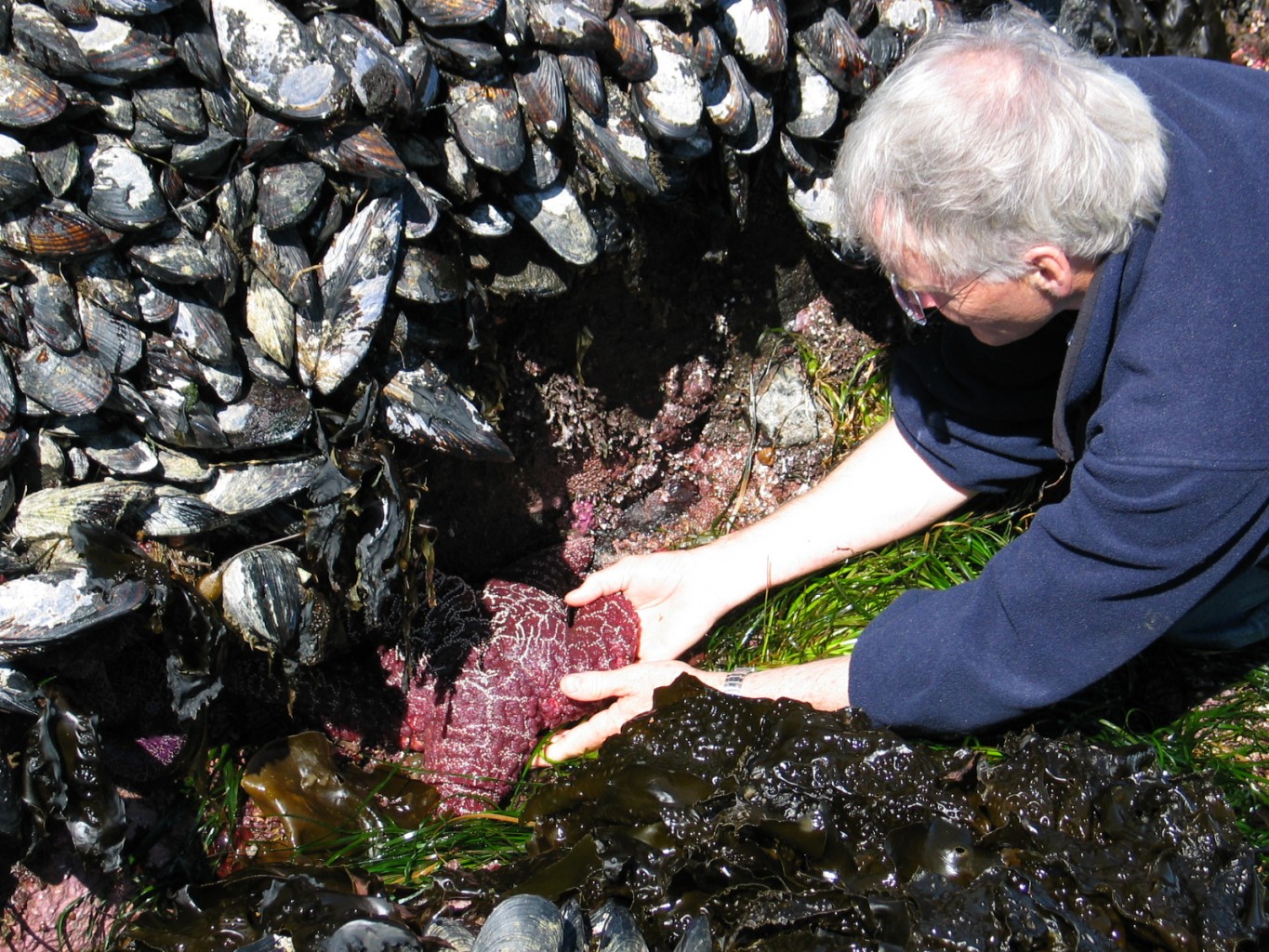 West Coast Wildlife Adventures approached to view the elephant seal also within 10 meters of the seal. I advised him he was too close since slash was there basking in the water. He had moved in to get a close look from a few metres. Images were placed on ecotourism page on web.
West Coast Wildlife Adventures approached to view the elephant seal also within 10 meters of the seal. I advised him he was too close since slash was there basking in the water. He had moved in to get a close look from a few metres. Images were placed on ecotourism page on web.
I found another black oystercatcher nest down in front of the Winch House, so moved camera3 over to it. (Update note on July 17–2 young were observed near the nest). In the morning I went out on the intertidal for the minus tide. Excellent long exposure of the surge channel and the cave on the South west side. Also got onto Anita’s intertidal island down from the helipad. I was looking for the large ( 45 cm diameter Purple star. Which I saw there two years ago, and at that time I thought he was the only one on the island. This time I found another smaller one– 30 cm diameter in a similar protected channel only 2 metres from the other one. Since these sea stars inhabit the lower intertidal zone, they cannot withstand the heavy wave action that occurs in that area without these deep channels which are protected by a rise on the seaward side to the west. As far as I know these are the only two purple stars occurring at Race Rocks. They are very common however in other sheltered inland coastlines in BC and are frequently the first sea star that visitors to BC shores notice. I also made note of a large number of very colourful brooding anemone exposed on the same protected mussel-covered wall on that island. There was an unusual abundance of blue ones which I remember to be rather rare when seen by diving in that area previously . One gull nest close to the science centre has chicks hatching.
Black Oystercatchers hatch today
On June 22, 2008, the Black Oystercatcher nest which was located on the rock just above the docks produced two chicks. They hatched in the morning and this set of clips was taken from a screen capture of camera 3 in intervals between 4:00 PM to 5:30 PM. They returned to spend the night at the nest, and left the next morning.
Video of Black Oystercatchers nesting today June 22,2008: by Garry Fletcher[/caption]
Camera on Oystercatcher
(‘2008-06-12’, 2, ‘Erik delivered Oil to RR in Second Nature. Garry installed new temp/humidity sensor, and changed cameras on nesting oystercatcher.. now camera 3. ‘Garry,07:45:12
Female Elephant seal: Scarlet
Scarlet , the often reported “Entangled” female Elephant Seal at Race Rocks.
 |
 |
 |
| This photo was taken at Race Rocks, middle Island, May 2, 2008 by a visitor on a whale watching vessel. | Photos taken on June 12 , | Close up of June 12 photo 2008. photos:Erik Schauff. |
| Return to the Elephant Seal Page. | June 2- 12- Staying on Middle Island, no evidence of change. It left shortly thereafter. |
 On January 29, 2009, an elephant seal looking much like the one from last year appeared, looking very pregnant. We believe she proceded to have her pup in the following week. It did not survive, and may have been still born. This page tells the story of the second and third pups born on Middle Island in February 2009.Pam Birley sent us this image which she took from the remote camera for the daily log. She gave the name “Scarlet” to this female. On January 29, 2009, an elephant seal looking much like the one from last year appeared, looking very pregnant. We believe she proceded to have her pup in the following week. It did not survive, and may have been still born. This page tells the story of the second and third pups born on Middle Island in February 2009.Pam Birley sent us this image which she took from the remote camera for the daily log. She gave the name “Scarlet” to this female. |
 Ryan had shot this image on January 24th 2009 of the female, showing the scars clearly on her stomach side only. Ryan had shot this image on January 24th 2009 of the female, showing the scars clearly on her stomach side only. |
 We also think now that this may have been the same female here back in 2004 when these pictures and video were taken. We also think now that this may have been the same female here back in 2004 when these pictures and video were taken. |
 Pam Birley has taken a few images on the remote camera that are included on her June 2009 gallery Pam Birley has taken a few images on the remote camera that are included on her June 2009 gallery |
Marine mammal Census May-June 2008
May 4 2008: photo in census file showing at least 3 elephant seals on Middle rock.
June 3 2008 Three male elephant seals were observed on middle rock. Two California and 1 Northern sealion are all that are left on the islands.
June 10, 2008 No Sea lions were seen. Very few harbour seals are around today. Estimated 10.
Two elephant seals on middle island, old Slash and one juvenile male ( dark colored)
Underwater Materials Performance Testing-Succession/Fouling
In December of 2007,The Pearson College Divers installed a set of junction boxes as part of a materials testing experiment for the tidal energy project
| Procedure 1 | Dec 7, 2007– Purpose: To test performance and resistance to fouling of PVC junction boxes and sealant compounds |
| Procedure 2 | Jan 10, 2008– Purpose: to test resistance to fouling and corrosion of different alloys of Stainless Steel as well as various types of fasteners. |
| Procedure 3 | Purpose: to protect submarine cables from chafing on sharp rocky edges |
| Procedure 4 | Purpose: To prevent corrosion of steel Ibeam supporting and holding power and control cables through intertidal zone. |
| Procedure 5 | Purpose: To provide ballast to steel Ibeam carrying power cables in intertidal zone preventing movement during heavy surge. |
- February 23, 2008e
- PVC boxes side
- PVC boxes top view
- Stainless steel alloys on block- no light
- Stainless steel alloys- illuminated
Visitors out
Garry and Catrin Brown and 2 students came out in Second Nature with the members of the West Coast Ecoadventure Group. Garry-18:35:39′
Calendula officinalis: marigold–The Race Rocks Taxonomy
Although introduced to Race Rocks by lightkeepers to brighten up their garden years ago, Calendula sp.is an interesting exotic since because of the ocean moderated temperature of the Ecological Reserve, it blooms at Race Rocks every month of the year. The reason it is so successful there is probably that it is not grazed by gulls or geese.
Also see the notation and images by Ecoguardian Anne Stewart, Sept 13 2015.
Scientific classification
Kingdom: Plantae
(unranked): Eudicots
(unranked): Asterids
Order: Asterales
Family: Asteraceae
Subfamily: Asteroideae
Tribe: Calenduleae
Genus: Calendula
species: officinalis
Other Angiosperms (flowering plants) at Race Rock
and Image File |
 The Race Rocks taxonomy is a collaborative venture originally started with the Biology and Environmental Systems students of Lester Pearson College UWC. It now also has contributions added by Faculty, Staff, Volunteers and Observers on the remote control webcams. The Race Rocks taxonomy is a collaborative venture originally started with the Biology and Environmental Systems students of Lester Pearson College UWC. It now also has contributions added by Faculty, Staff, Volunteers and Observers on the remote control webcams. |
Pat Carney finally wins her lighthouse fight, TC, May 15, 2008
News Column: By Jack Knox, Pat Carney finally wins her lighthouse fight, Times Colonist, May 15, 2008
“Busy Saturday for Pat Carney on Saturna Island this weekend. After the market at the recycling centre, where she’ll be selling garden plants for her church, it’s off to the open house at the East Point lighthouse.
That open house might not seem like a big deal to some, but to Carney, just retired from the Senate, it symbolizes victory.
For almost 10 years, Carney has been striving to save B.C.’s crumbling, historic lighthouse buildings, or at least arrange it so that community groups can get their mitts on them and put them to good use. Six times she tried to push through legislation that would allow that to happen. Six times she failed, Sisyphus pushing that boulder up the hill, only to see it roll back again.
But lo and behold, her seventh attempt finally made it all the way through Parliament this month — four months after the Saturna resident flew home from Ottawa for the last time. Shows what persistence will do.”
…….Continued, see the full article here:
Pat Carney finally wins her lighthouse fight, Times Colonist, May 15, 2008
News Release : After Nearly 10 Years – Heritage Lighthouse Bill Passes

NEWS RELEASE
Date sent: May 7, 2008
FOR IMMEDIATE RELEASE
After Nearly 10 Years – Heritage Lighthouse Bill Passes
OTTAWA – A private member’s bill which empowers communities to help preserve Canada’s heritage lighthouses was passed by Parliament Wednesday after nearly ten years in the political process.
Bill S-215, sponsored by former BC Senator Pat Carney, who retired earlier this year, cleared both the House of Commons and the Senate and is expected to receive Royal Assent shortly.
The legislation establishes a process for communities to initiate the selection of heritage lighthouses under criteria established by the Minister of the Environment who is responsible for Parks Canada. It also prevents their unauthorized alteration or disposition and requires that they be reasonably maintained. It applies only to 256 federally -owned lighthouses, most fully operational guardians of maritime safety.
“Until now lighthouses deemed surplus to operational requirements have been burned down, blown up or demolished without consultation with adjacent communities,” said Carney, who resides on Saturna Island, where a historic lighthouse and a light-keeper’s house were destroyed when an automatic light tower was installed.
There are federal lighthouses in every province except Alberta and Saskatchewan. MP Larry Miller, who carried the bill through the Commons and whose Ontario riding (Bruce-Grey-Owen Sound) has several lighthouses said: “We all have a winner here.”
Moving third reading in the Senate, Wednesday, Senator Lowell Murray noted the original version of the bill was introduced in 2000 by the late Senator Mike Forrestall of Nova Scotia, supported by Barry MacDonald of the Nova Scotia Lighthouse Preservation Society. Successive bills have failed to make it through the legislative process.
A supporter of the preservation initiative since 1999, the Heritage Canada Foundation (HCF) welcomed the passage of the bill. “It’s a momentous day for Maritime heritage in Canada,” said Natalie Bull, executive director. “HCF looks forward to working with local community groups to seize this conservation opportunity.”
Department of Fisheries and Oceans has a program to divest surplus lighthouses in Atlantic Canada to communities for social and economic uses, such as tourist destinations. But many operational lights such as BC’s Race Rocks, built in l860, are crumbling and in a state of disrepair. DFO, which owns most federal lighthouses, has no mandate to preserve them.
The legislation will come into force in two years in order to enable the Minister to establish criteria for heritage designation with the assistance of an advisory council. Communities will have a further two years to petition the Minister for heritage designation and to propose community uses for any building surplus to operational requirements.
Carney said her Saturna Island community is planning to transform an abandoned Fog Alarm Building at the operational East Point lighthouse into a Discovery Centre featuring the Spanish and British maritime explorers who first charted the surrounding waters. Saturna is named for the Spanish ship “Saturnina”.
The Heritage Canada Foundation is a national, membership-based, non-profit organization with a mandate to promote the preservation of Canada’s historic buildings and places. HCF urges local community groups to contact its headquarters for more information and advice on next steps.
– 30 –
Contacts:
Parks Canada Honourable Pat Carney, P.C.
Becky Smith (tel.) (250) 539-5280
(819) 997-1441 (Cell) (604) 992-7109
(819) 953-0279 patcarney@telus.net
Heritage Canada Foundation Tracy Bellefontaine
Carolyn Quinn, Director of Communications Policy Analyst, Senate of Canada
613-237-1066 ext. 229 (613) 996-7059


